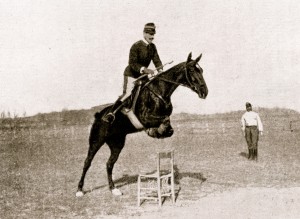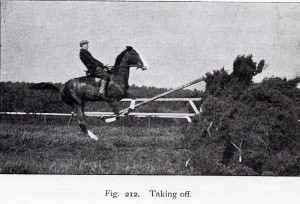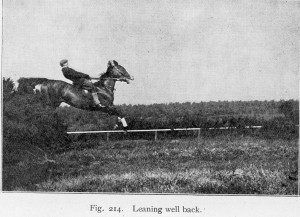On numerous occasions I’ve sat in front of my keyboard intending to start a series of blog posts comparing several horsemen who had strong influence over modern American riding. On each occasion I have gotten mired down in history that I find most fascinating but side tracks me from my goal. One path I find myself traveling frequently has to do with Federico Caprilli; the origins of forward riding, the methods of the day, and the controversy over the methods. The Italian school didn’t actually fully implement Caprilli’s ideas until around the time of his death in 1907 and Caprilli’s ideas did not begin to spread greatly until after that time period. (I find myself wondering how things would have gone had Caprilli the advantage of an ASTM/SEI helmet but you see here I go hopping down the bunny trail again!)
When I first started thinking about Caprilli I read books by Piero Santini, Vladirmir Littauer and Paul Rodzianko. There was little on the internet about Caprilli. . . Well, there wasn’t that much on the internet about anything. Things have changed. In 2015 there are many sites which “speak” authoritatively about Caprilli – most of them are just spewing out a regurgitated version from another site forgetting where their thought originated. It’s a bain of the internet. A few call Caprilli “our savior” and most of them indicate that he single handedly had the unique thought that created the modern forward seat – or hunter seat – or hunt seat- or jumping seat or. . .?

There really isn’t a lot of information about Federico Caprilli. He was just another cavalry officer who taught riding during a time horses were of paramount importance to a military trained in classical riding for generations; a type of riding that took much skill and created a rider-dependent horse with artificial balance. Caprilli looked for a better, more natural way for soldiers to ride; a way that could expedite rider education and be useful in modern warfare.
I wondered, was Caprilli the only person who thought about riding in a simplified, balanced manner, away from horses with faces on the vertical and balance in their middles? What about the Mongols who rode with shorter stirrups, leaning forward? What about the American Native who crouched on his pony and hung to the side in disguise? What about jockey Willie Simms who rode with short stirrups crouching over his horse’s shoulders to give him better balance. Between 1887 and 1901 Willie Simms won more than 1,000 races. And then there was Indiana born jockey, Tod Sloan who raced in America and England during the 1890s. Here’s what he says in Tod Sloan by Himself (pages 22-23)
“ One day, when I and Hughie Penny, who was then a successful jockey, were galloping our horses to the post, my horse started to bolt and in trying to pull him up I got up out of the saddle and on to his neck.
Penny started laughing at the figure I cut, and I laughed louder than he, but I couldn’t help noticing that, when I was doing that neck crouch, the horse’s stride seemed to be freer, and that it was easier for me, too. Before that I had seen a jockey, named Harry Griffin, riding with short stirrups and leaning over on the horse. As he was the best jockey of the day I put two and two together and thought there must be something in it, and I began to think it out , trying all sorts of experiments on horses at home. The “crouch seat,” the “monkey mount,” or the thousand and one other ways it has been described, was the result. Then the time came when I determined to put it into practice. But I couldn’t screw up enough courage the first time aI had a chance. I kept putting it off. At last though, I did really spring it on them. Everybody laughed. They thought I had turned comedian. But I was too cocksure to be discouraged. I was certain that I was on the right track. I persevered, and at last I began to win races!”
In the broad view, people were riding forward, trying to get the best performance out of their horse or in the case of Mongols and Natives, riding in the way that felt the most natural, both during Caprilli’s time and earlier, so what’s the big deal?
Part of the importance of Caprilli’s contribution to our modern riding is that he changed the way we sit when we jump fences but was that his goal? Actually his goal was to make horses and riders efficient for war. He believed that classical equitation made a horse useless over varied terrain and was too difficult for the average person to learn quickly; that the horse should be allowed to maintain his own natural balance with as little interference from his rider as possible. Caprilli did more than just ride and jump forward. He developed a system.
Strong opinions reign in horsemanship and the end of the 19th, moving into the 20th century was no different. Caprilli dared to go against the establishment and classical riding, to get the Italian cavalry school to accept his ideas. (Later on the Italian Olympic Team refused to participate in dressage in the Olympics.)
M. Horace Hayes, (1842-1904), well respected horseman in England and fellow of the Royal College of Veterinary Surgeons was a prolific author. His work Veterinary Notes for the Horse Owner had more than 17 editions and is still in print today. In Riding on the Flat and Across Country (published 1881) he gives his view of the prevailing seat of the day:

“… ‘Sitting down’ at the gallop or canter, or over fences, the rider should get his seat under him as much as possible, which will be done by keeping the body erect by the ‘play’ of the hip joints, and not by hollowing out the back, for that would cause the seat to be stuck out behind, instead of being carried beneath the centre of gravity of the body.
He should force his fork well down into the saddle, with the hollow, and not the back of the thighs against the flaps. The knees should be well forward; the legs from the knee down should be vertical, or, if anything, somewhat drawn back, while the feet should be parallel to the sides of the horse, with the heels slightly depressed. The legs should be kept close to the horse’s sides, so a certain amount of grip may be obtained by the calves of the rider’s legs.”
Hayes probably would not have known Caprilli but he did have an opinion on forward riding. In Riding and Hunting (published 1901) he refers to Tod Sloan and Willie Simms and “The so-called American “crouching seat” :
“Up to the arrival of Simms in 1895, followed by Sloan in 1897, all our modern jockeys rode with their stirrups at the usual length. To obtain full benefit from this seat in bringing the weight forward, the jockey has to shorten his stirrups, so that his knees will be almost on a level with the withers of his mount, by doing which he will necessarily deprive himself of the valuable assistance he can obtain form his legs in guiding, collecting and stimulating his horse. . . The manner in which many of the crouching jockeys bump up and down in their saddles is a travesty of good horsemanship. . . Sloan’s seat was a style of riding that no English jockey ought to have adopted,. . . It is a pitiable sight to see the unbalanced manner in which many race horses, especially big raw two year olds, struggle along swerving and rolling in their efforts to gallop under riders who, by reason of their crouching seats, have not the ability to collect them to gallop in a level manner. What appears to be gained in the crouching seat offering less resistance to the wind is also, to a large extent, nullified by the fact that this seat puts more work on the muscles of the forehand, it is only suitable for short distance racing as it is too fatiguing to the horse. As so many of our best trainers are strongly opposed to this style of riding, and consider that it handicaps nine horses out of every ten, the English imitators of Sloan not having achieved much success, it is possible that we may have a revival of the more finished style of English race riding. At the present there is a lamentable dearth of really fine jockeys.”

As far as jumping went, there was no set way to jump a horse and the opinion of whether or not horses should jump varied. Some said jumping devalued the horse. Others taught that you approached the jump at a walk, pulling the horse back on its hindquarters while you leaned back both on take off and on landing. Others taught that although you lean forward into the jump, you leaned back on the descent, in order not to burden the horse’s forelegs. Nonetheless, the National Horse Show held at Madison Square Garden in 1897 had classes for hunters and jumpers with fences ranging from 5 feet to 6’6”, which is not an insignificant height. (Incidentally the smallest horse in those classes was 14.3 hands and the largest was 16.2 1/2 hands)
Caprilli considered the physical comfort and discomfort of the horse, but he also considered their mental conditions. He knew a horse who was frightened or in pain would not be able to handle the demands of riding and jumping. Horace Hayes devotes chapters to horses with vices, referring to them as having “various faults of temper and mouth” and “the procedures a rider ought to adopt if he finds his mount to be fractious, and has got no time to break him.” (From Riding and Hunting by Hayes). Where Caprilli would prevent horses from developing vices through understanding their physical abilities and mental condition, Hayes gives all sorts of corrections for horses with “vices” that result from the mishandling that appears to be normal for the time.
Horace Hayes died 3 years earlier than Caprilli but at a much older age. Hayes leaves us a profile of the training of and attitude toward horses in the public venue in his day. Caprilli bucked the established system for training military horses in the classical dressage of the time. I wonder if he considered anything beyond his immediate circle of influence? Certainly he had no idea that his views and system would effect the entire world for generations, improving the life and performance of countless horses. Call it being at the right point in history or call it unintended consequences, Caprilli’s short life and investigative mind gave horsemanship a new direction.
Thank you of reading U.S. Horsemanship,
Barbara Ellin Fox
bfox@ushorsemanship.net

I have forgotten his name/website, but he lives in Virginia/north Carolina…that area…he partially translated Frederico caprilli’/article but last year? or just before..translated the entire article. Frederico Caprilli’ was an amazing man. He did more than change riding. Like you said, an astm helmet.
I would love to learn more about him. What an amazing man. Barbara Kinsey
What do I think? I think it is an excellent article exhibiting your usual balanced and unbiased approach in all your writings and comments.I congratulatre you.
Hi Barbara,
You’re thinking of Dan Gilmore http://gilmorehorsemanship.com . My next post will talk about the value of Dan’s translation of Per L’ Equitatzione Di Campagna and also about Piero Santini. In my view Dan is the modern day authority on Caprilli but investigate his site, particularly his blog. Dan has a lot to offer.
Thanks for your comment and thanks for reading U.S. Horsemanship!
Barbara
Dear Roger,
Thank you for your very kind comment. It’s always encouraging. U.S. Horsemanship had to “balk” for a bit while life took over but I’m happy to be back at it. I’m looking forward to a series of posts that try to discuss the basics of forward riding and some of the changes that were brought in through the next horsemen to impact this type of riding. I hope we can get lively conversation started!I’m looking forward to your input.
Barbara
Barbara, thank you so much for this new article on Caprilli.
I have been riding Forward Seat for 44 3/4 years now. Throughout the decades Caprilli has been my inspiration for humane riding. When I learned I had Multiple Sclerosis over 20 years ago I sat down and thought about riding as a crippled woman, and I came to the conclusion that the FS was the MOST SECURE seat even if I can no longer jump, ride cross country, or even do the gallop. I was lucky and found a riding teacher nearby me (I’m near Charlotte, NC) that was willing to listen to me and willing to teach me within the parameters of the FS after I educated her about the particulars. It was not hard, she had been teaching hunt seat for a long time,and the pure FS was just a refinement of what she already knew. The reason she listened to me was that she LIKED how her horses reacted to my riding, she liked how her horses moved under me, and she liked how her reactive Arabs calmed themselves down when I rode them in spite of my uncertain balance, hand tremors, and less than steady lower legs.
When I re-started riding after my diagnosis I realized that if I was to have any hope for the horses to listen to me I would have to listen to the horses myself. After several years I finally realized that one big facet of the Caprilli revolution was that HE LISTENED TO WHAT THE HORSES WERE TELLING HIM ABOUT HIS RIDING, and considered their comments and reactions as valid. I consider Caprilli’s Forward Seat as the only riding system that literally comes from the horse’s “mouth.” In honor of Caprilli, whenever a horse starts “cursing” me out for my riding, I listen to the horse and alter my riding until the horse becomes calm because he is more comfortable. Personally I get a kick when these super reactive Arabs calm down under me, forgive me my many, many, many riding faults, and end up going around the ring looking like calm cow-ponies rather that fire breathing dragons!
I am greatly looking forward for your future blogs on Caprilli and the Forward Seat.
I actually have a 1901 edition of “Riding and Hunting” by Matthew Horace Hayes. An excellent book well worth reading and for comparing with other riders/authors of that time period.
My copy of Riding & Hunting is 1971. Will check it out as taking it easy this week. Barbara
Jackie – I’m glad to know that you are still riding. You face a real challenge.
Thank you for commenting and for reading U.S. Horsemanship.
Barbara
Hi Dan,
When you read through Hayes it becomes apparent that there was as much controversy and passion involved in topics about horses back then as there is now…has always been. I get the impression that Horace Hayes would have liked to rid the horse world of any vermin that rode forward! I have another of his books Riding on the Flat and Across Country – 1881 – also interesting. When I go through these old books I’m amazed how much of what was still is.
It’s good to hear from you. I think Santini needs to come next.
Barbara
Barbara,
I hope taking it easy is for a pleasant reason such as a vacation.
I lived 2 blocks from the local country library on Long Island as a kid. Drained them of books on horses. Horace Hayes was among them. The old books were not so old then and I was quite sure jumping was the most important thing you could do with a horse. That probably planted the first seeds of interest in equestrian history for me. How about you? How did our interest begin?
Barbara